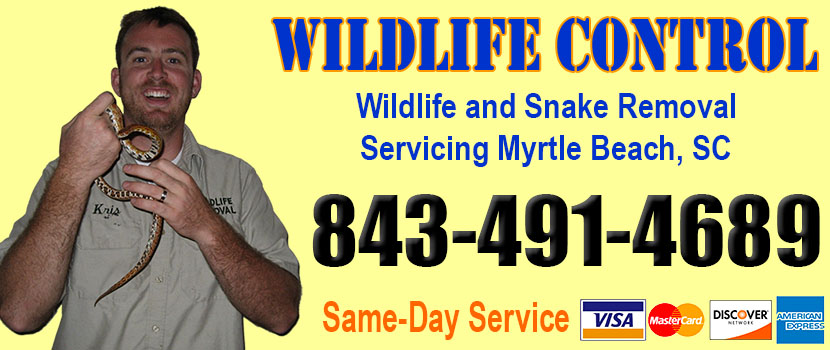
Welcome to myrtlebeachsnakes.com! I am David, a snake enthusiast living in Myrtle Beach, SC. Many people don't know that Myrtle Beach is in fact full of snakes! You just need to know where to find them - they can often be shy and elusive. Some South Carolina snake species are more common outside of the city limits, in different parts of Horry County SC, but many types of snakes are indeed common in the more urban parts of Myrtle Beach. This guide is meant to help educate you about the beautiful snakes of Myrtle Beach, and to help you identify the most common snakes of Myrtle Beach, as well as the venomous snakes of Myrtle Beach that you should learn to recognize and avoid. If you want more detail, click here for my complete list of ALL snake species in Myrtle Beach. Remember the following:
- Most snakes of Myrtle Beach are harmless and don't want to encounter you
- Venomous snakes exist but are uncommon in Myrtle Beach, South Carolina
- Snakes eat rats and mice and are a valuable part of the South Carolina ecosystem
- Never kill a snake - if you leave a snake alone, it will leave you alone.
Venomous Snake Species in Myrtle Beach
 Copperhead:
The copperhead has a variety of colors that range from pink to tan and has dark brown spots along its body. An adult copperhead can grow to 4 feet long. It is easy to confuse a copperhead with a rat snake, which is harmless. The difference is that a rat snake has a small narrow head while copperheads have large triangular heads, and while rat snakes have round pupils as humans do, copperheads have cat-like vertical pupils. Copperheads are nocturnal snakes and the least venomous of the snakes. When they strike at humans, copperheads do so from a distance that is too far to be fatal.
Copperhead:
The copperhead has a variety of colors that range from pink to tan and has dark brown spots along its body. An adult copperhead can grow to 4 feet long. It is easy to confuse a copperhead with a rat snake, which is harmless. The difference is that a rat snake has a small narrow head while copperheads have large triangular heads, and while rat snakes have round pupils as humans do, copperheads have cat-like vertical pupils. Copperheads are nocturnal snakes and the least venomous of the snakes. When they strike at humans, copperheads do so from a distance that is too far to be fatal.
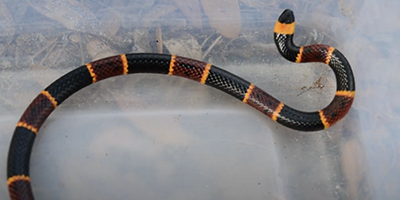 Coral snake:
It is easy to recognize coral snakes by their characteristic yellow, bright red, and black bands. However, you may likely not see a coral snake because it is nocturnal and avoids humans at all costs.
Coral snake:
It is easy to recognize coral snakes by their characteristic yellow, bright red, and black bands. However, you may likely not see a coral snake because it is nocturnal and avoids humans at all costs.
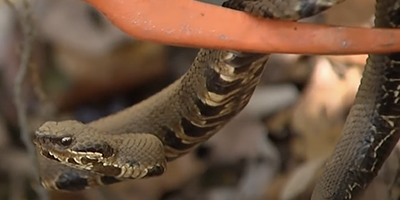 Cottonmouth:
This is also known as the water moccasin and is the most common venomous snake in South Carolina. This snake species uses aggressiveness as a cover, and though their bite can be fatal, they turn to it as a last resort. When this snake feels threatened, it opens its mouth and shows the white part of its mouth; this earned it the name "cottonmouth." It also vibrates its tail and gives off a musky scent that some attribute to the smell of cucumbers. Studies show that most cottonmouth bites occur when people pick up the cottonmouth. It is easy to tell that a cottonmouth is close by the earthy and musky scent it gives off, even when its perceived threat is still far away.
Cottonmouth:
This is also known as the water moccasin and is the most common venomous snake in South Carolina. This snake species uses aggressiveness as a cover, and though their bite can be fatal, they turn to it as a last resort. When this snake feels threatened, it opens its mouth and shows the white part of its mouth; this earned it the name "cottonmouth." It also vibrates its tail and gives off a musky scent that some attribute to the smell of cucumbers. Studies show that most cottonmouth bites occur when people pick up the cottonmouth. It is easy to tell that a cottonmouth is close by the earthy and musky scent it gives off, even when its perceived threat is still far away.Many confuse water snakes with cottonmouths because of the similarities in color and sometimes sizes. People have killed harmless water snakes with the intent of getting rid of a cottonmouth. Water snakes have the arrow-shaped head that most associate with cottonmouths and this gets them killed easily. The killing of either of the two species is unnecessary, as none of them is potentially harmful to humans. Cottonmouths will stand their ground when they feel cornered, unlike most species of snakes, but will never bite unless it is the only available option.
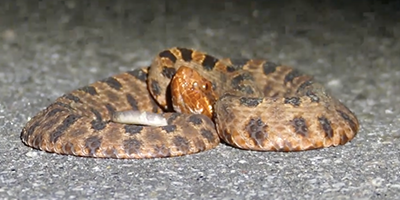 Pygmy rattlesnake:
Although these snakes hardly grow more than a foot long, you should not overlook them, as they can be dangerous. They have a range of colors from charcoal grey and pink to light gray and have dark spots across their bodies.
Pygmy rattlesnake:
Although these snakes hardly grow more than a foot long, you should not overlook them, as they can be dangerous. They have a range of colors from charcoal grey and pink to light gray and have dark spots across their bodies.
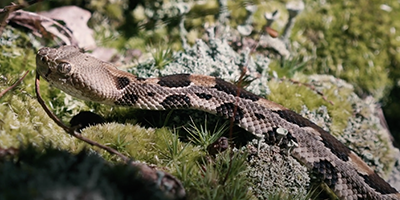 Timber rattlesnake:
This rattlesnake with the zoological name Crotalus horridus is known as the timber rattlesnake in the mountains and the canebrake rattlesnake in the coastal plains. This is South Carolina's most common wide-ranging rattlesnake and one of the largest. This rattlesnake species makes its home in every terrain type available, from the pinewoods and forests to coastal lands, and although they are terrestrial snake species, it is very possible to see them swimming in lakes and wide rivers.
Timber rattlesnake:
This rattlesnake with the zoological name Crotalus horridus is known as the timber rattlesnake in the mountains and the canebrake rattlesnake in the coastal plains. This is South Carolina's most common wide-ranging rattlesnake and one of the largest. This rattlesnake species makes its home in every terrain type available, from the pinewoods and forests to coastal lands, and although they are terrestrial snake species, it is very possible to see them swimming in lakes and wide rivers.The difference between both rattlesnakes comes in their colors. The timber rattlesnake has a range of colors from black to yellow, while the canebrake can be light tan, pink or light orange. However, both species have dark bands across their back and a rattle tail.
If you're unsure, you can email me a photo of the snake at info@myrtlebeachsnakes.com and I will email you back with the snake's species. If you found a snake skin, read my Found a Skin? page, and you can email me a photo of the skin, and I'll identify the snake for you. If you need professional Myrtle Beach snake removal help, click my Get Help page, or see the below website sponsor I found, who provides that service.
A Comprehensive Guide on Shed Snake Skin
Snakes are unique wildlife creatures due to a range of reasons. Perhaps, one of their strange attributes would be their ability to shed their skin in one go, a process known as ecdysis. The snake will shed their skin since they need to create more room for growth. The younger they are, the more frequently they will do this. Additionally, they can also do this when removing the parasites and bacteria on their skin.
How Often Do Snakes Shed Their Skin?
The number of times they will shed their skin will depend upon their age, health, and species. Some of them, mainly the younger snake, may shed their skin 1-2 times per month. However, for the older snake, they may only do this once a year. Before they shed their skin, you will notice that their scales will appear bluish. Their eyes may also appear opaque and clouded. It is a sign that the newly formed skin is covering their eyes. While they can correctly see their environment, they are still extremely vulnerable during this time. Therefore, they will look for a safe place to remove their skin.
Where Can You Find Shed Snake Skin?
Snakes will not shed their skin in their hunting site since they may expose themselves to some danger. They will generally look for a place that has no signs of their predators. The snake will begin the molting process by rubbing its skin against the tree, rock, or other rigid and rough surfaces. They can remove their old skin by wriggling on plants and stones, and other similar surfaces. There are also species of snakes that can shed their skin while on the waters. They will leave the shed skin behind, that most people will find. It is a sign that a snake has been close by.
How Does Shed Snake Skin Look Like?
The skin of the snake will show a variety of detail that an expert can use to determine the species of snake. They can look at the pattern of the snake and the location of its eyes. There may also be visible markings and banded patterns, which will help a lot in identifying the snake. However, if it has been exposed to different outdoor elements, the quality of the snakeskin can be affected, which will make it difficult to distinguish the patterns. In addition, some snakes may share the same feature that can increase the probability of misdiagnosis. Sure, you may relate the skin to some of the pictures online, but you need knowledge and experience to determine the snakes through the shed skin accurately.
Shedding skin is a natural process that occurs in the animal kingdom. Even humans will shed their skin to encourage the growth and development of new skin cells. However, what makes the snake unique is that they do this in one go. Most animals will shed millions of skin cells, but it is a continuous process, and the particles are microscopic, making them less noticeable.
Remember, the term is not poisonous snakes of Myrtle Beach, it's venomous snakes of Myrtle Beach. Poison is generally something you eat, and venom is injected into you. That said, dangerous snakes are very rare in Myrtle Beach. The few venomous snakes of Horry County are rarely seen. But they are commonly misidentified, so learn about all the snake species of Myrtle Beach in order to correctly identify them. These snakes are usually also found in the surrounding towns of Myrtle Beach, Conway, North Myrtle Beach, Little River, Surfside Beach, Loris, Aynor, Carolina Forest, Socastee, Garden City, Atlantic Beach, Forestbrook, Bucksport, Briarcliffe Acres, Red Hill and the surrounding areas.
Read our article about:
Poisonous Snake or Venomous Snake?
myrtlebeachsnakes.com domain and hosting costs made possible by the generous support of this sponsor:
